Mike Bryant website, dive trips and photo galleries.
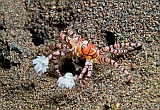
Mosiac Boxer Crab. Size
of a quarter, clutches
little anemones in its
claws to catch food. The
anemones get enough
too.
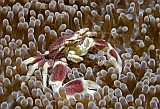
Porcelain Crab in
anemone.

Decorator Crab, 3/4 inch
covered with little living
anemones. They get a
ride, the crab gets
camouflage.
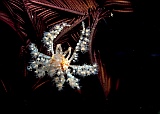
Decorator Crab.
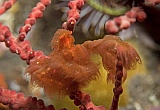
Orangutan crab. Another
decorator crab, It covers
itself with brown algae.
This is a big one--an inch
wide. Same coloring as
the Orangutan great ape,
found in Borneo and
Sumatra.
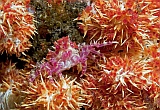
Soft Coral Crab in soft
coral. If you look closely,
it has attached little
toupees of soft coral to
itself. Half inch maybe.
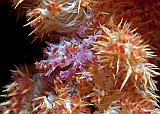
Soft Coral Crab
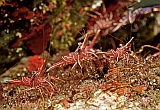
Bruce's Hinge-Beak
shrimp. And no, I don't
know who Bruce is.
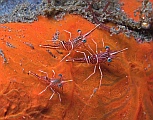
Bruce's Hinge-Beak
shrimp.
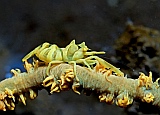
Zanzibar Whip Coral
Shrimp. These are awful
to photograph. They live
on long, thin (15 feet)
corals that move in the
current. They are less
than 1/2 inch long and
they dart up, down and
behind the coral. Best I
have ever had!
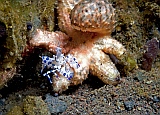
Harlequin Shrimp. These
can get big, four inches.
This was not one of them,
maybe half inch. The
"claws" are more like
chisels and they feed on
sea stars like the one it is
on. The sea stars can
regenerate the eaten
limbs.
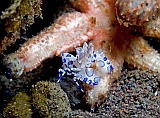
Harlequin Shrimp
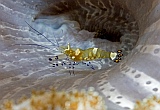
Peacock Tail Anemone
Shrimp
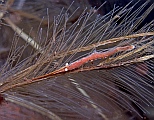
Ocellated Tozeuma
Shrimp on stinging
hydroid.
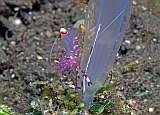
Magnificent Anemone
Shrimp
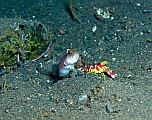
Probable Freckled
Shrimpgoby with
unknown shrimp. They
live together, the shrimp
excavates and cleans the
burrow, the goby
provides the food and
alarm system. Hundreds
of species, worldwide,
with many different
cohabiting shrimp.
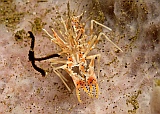
Spiny Tiger Shrimp--half
inch
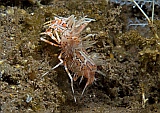
Spiny Tiger Shrimp
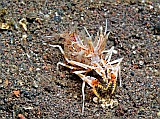
Spiny Tiger Shrimp
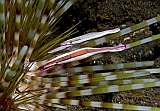
Purple Urchin Shrimp.
Another photographic
nightmare as they live in
the sharp spines of sea
urchins. And the spines
will point at you when
you approach.
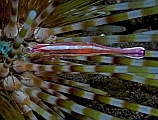
Purple Urchin Shrimp
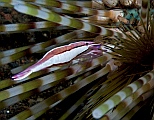
Purple Urchin Shrimp

Purple Urchin Shrimp
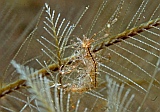
Skeleton Shrimp living in
hydroid. The "fluff" on it
is juvenile skeleton
shrimp. About 1/4 inch.
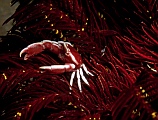
Crinoid Crab, living in
crinoid.
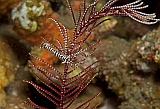
Crinoid Shrimp. Many
species.
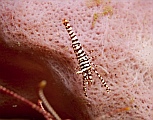
Crinoid Shrimp
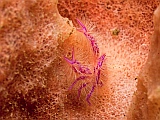
Hairy Squat Lobster.
Lives in sponges, maybe
3/4 inch. Not edible.
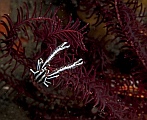
Elegant Crinoid Squat
Lobster, 3/4 inch.
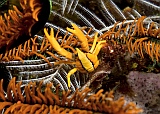
Baba's Crinoid Squat
Lobster. Less than half
inch.
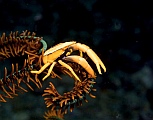
Baba's Crinoid Squat
Lobster
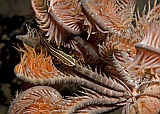
Crinoid fish. Not sure on
this one. Less than 1/2
inch.
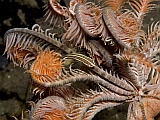
Crinoid fish
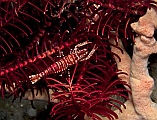
Crinoid Shrimp. Half inch
maybe.
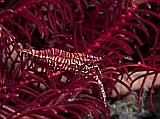
Crinoid Shrimp. Note that
all these crinoid dwellers
have colors that mimic
the host.
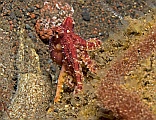
Octopus. Small--two
inches. Note how it's
standing up to look
bigger.
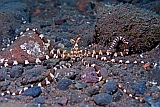
Wonderpus. First
identified in 2006 and
only known in the
Indonesian area. This one
is six inches wide.
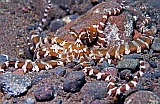
Wonderpus
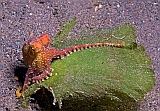
This looked like a leaf on
the sand. Then the leaf
moved. And more
investigation showed a
two inch octopus using
the leaf like an umbrella
to cover itself to make it
"invisible". Here it is,
walking on the sand,
using an arm to hang
onto the leaf. It will flip
the leaf back over itself
as soon as I stop
messing with it.

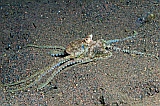
Octopus, tiny, on the
sand.
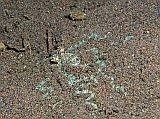
Octopus, tiny, burying
itself in the sand.
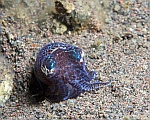
Tropical Bobtail Squid.
The smallest squid, this
one is the size of a
thimble.
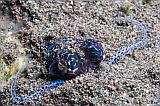
Bobtail Squid. It's using
it's tentacles to "row"
itself out of sight into the
sand.
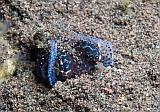
Bobtail Squid, almost
hidden in the sand.
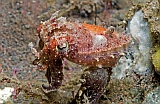
Flamboyant Cuttlefish--
two inches
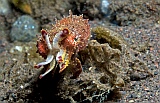
Flamboyant Cuttlefish
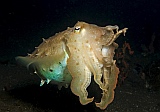
Broadclub Cuttlefish.
They communicate by
flashing color changes.
That blue look is not a
sign of happiness that I
am there.
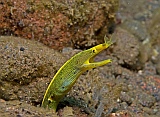
Ribbon Moray, female.
Adult males are blue.
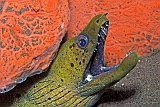
Fimbriated Moray Eel
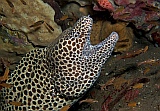
Blackspotted Moray
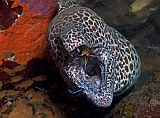
Blackspotted Moray with
cleaner shrimp and blue
wrasse in mouth.
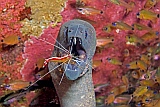
Yellowmargin Moray with
White-banded Cleaner
Shrimp.
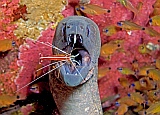
Yellowmargin Moray with
White-banded Cleaner
Shrimp.
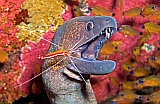
I tried four times to get
this shot with the
Blackspotted (and MUCH
larger) moray in the
preceding pictures. But
this one was on the other
side of the cleaning
station and was far more
cooperative.
Bali, Indonesia 2012. Creatures.
Home
Click HERE to enter galleries.
Indonesia 1. The Good.
Indonesia 2. The Bad.
Indonesia 3. The Ugly.
Indonesia 4. Nudibranchs.
Indonesia 5. Critters.
Great White Shark
St Vincent, 2009
Red Sea, Egypt 2009
Galapagos Underwater
Galapagos Land
Machias Seal Island, Maine. June 2010 and May 2019
St Kitts and Saba, August 2010
Philippines, Puerto Galera January 2011 Fish.
Philippines, Puerto Galera January 2011 Creatures
Fiji, May 2011. Beqa Reefs
Bali, Indonesia 2012. Fish.
Bali, Indonesia 2012. Behaviors and critters.
Bali, Indonesia 2012. Nudibranchs.
Blue Heron Bridge, Riviera Beach, Florida.
North Sulawesi 2013. Pipefish and Seahorses
North Sulawesi 2013. Fish
North Sulawesi 2013. Mostly Nudibranchs
North Sulawesi 2013. Crabs and Critters
North Sulawesi 2013. Cuttlefish and Octopus
Blue Heron Bridge, May 2013
Komodo, Indonesia. August 2014 and 2019 daytime
Komodo, Indonesia. August 2014, night dives
Philippines, Dumaguete 2015 Fish
Philippines Dumaguete 2015, Creatures and Critters
Dominica 2015 and 2017. Before Hurricane Maria
Raja Ampat, January 2016
Cayman Islands, October 2016
North Sulawesi 2017. Fish
North Sulawesi 2017, Creatures
Anilao, Philippines 2017. Fish
Anilao, Philippines 2017. Eels, Pipefish
Anilao, Philippines 2017. Crabs, shrimp, octopus.
Anilao, Philippines 2017. Nudibranchs.
Triton Bay, Indonesia. 2018
Villa Markisa, Tulamben. Bali, 2018. Fish and Creatures.
Villa Markisa, Tulamben. Bali, 2018. Nudibranchs.
Solomon Islands, April 2019
Siladen Resort. Siladen Island, Indonesia 2020
Coral Triangle. Things with stings.
Coral Triangle. Frogfish.
Coral Triangle. Crabs & Shrimp.
Coral Triangle. Cuttlefish, Octopi and Squid.
Coral Triangle Butterfly and Angelfish
Belize, October 2021.
There are some wonderfully weird creatures that can be found (sometimes with great
difficulty) in and on pretty much everything. They may live in crinoids or stinging
hydroids, in and on sponges and corals or buried in the black volcanic sand.
Some shrimp and small fish act as cleaners--removing dead scales or parasites from
larger fish and eels. It's always entertaining to find one of these "cleaning stations"
and looking at the parade of animals coming to it and a mass of shrimp rising up to
clean. It works well for both, the cleaners gat a meal, the animal gets rid of
annoyances.
Many of the subjects here are really tiny. It's a pity I can't put a dime next to them for
scale but it's hard enough getting the focus down onto something that may only be a
quarter inch long. And moves. Underwater.
CLICK ON THUMBNAIL FOR FULL SIZE IMAGE THEN "PLAY" TO ACTIVATE
SLIDESHOW, OR CLICK "NEXT" FOR PICTURE BY PICTURE ACTIVATION.






















































